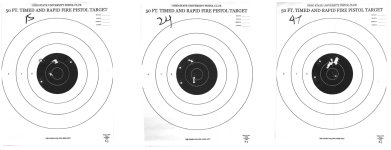random guy said:
Well, that's what I thought, that the difference would increase proportionally with range but from what I can tell from my small and sloppy sample (I cannot explain the low flyers in both groups) there is virtually no elevation change to proportionally increase. At least nothing like we are used to seeing in revolvers. 4 X 0 is still zero. 4 X 1/2" would only be 2" at 50 yards. Not much.
Something has changed, and I can't post from Photobucket as I used to. I can, presently, only show the targets in question
as an attachment. Click on the "attached Images" link at the bottom. I have posted other images here recently, using the [ IMG ] function, but it wouldn't work this time out.
When I look at the target, I shudder, as my personal shooting performance was terrible. But, I was rigorous in doing everything the same. (The target says 50' but it was shot at 30'-35'.) A first shot that was not part of the test was shot off target so that the first TEST ROUND was chambered by the gun cycling, and not done manually.
I shot the first test round on the first target using a 115 gr round, then the second using a 124 gr. round, then the third using a 147 gr. round, and then came back and repeated the process until all 15 rounds were fired. The rounds were loaded in the mag to allow that. I used the same point of aim on each target, and sights were not adjusted. (My eyesight has been adjusted since then, via cataract surgery... That might make a difference if I try it again.)
I don't know why the 147 gr. rounds made bigger holes in the paper, but they did.
random guy said:
... Another factor may be the simple difference in total recoil between magnum revolvers and a 9mm. It's not like the 9 just lays there though. This really has me wondering.
I'm not sure the total difference in recoil matters as much as it seems it should.
As I've noted in earlier replies, until the bullet has almost moved out of the barrel, there's not much connection between the slide and barrel
and the frame, and until THAT connection becomes more direct and forceful, there's not much way for any recoil (heavy or light) to have an effect on the frame (and barrel rise.)
The relationship of the bullet, barrel and slide, until the bullet leaves, is based on a fixed, physical relationship, and faster, slower, heavier or lighter bullets don't change that fixed physical relationship. The only thing that changes is the speed with which it is all takes place. But when the bullet is moving as part of that relationship, the timing doesn't seem to matter much, either.
Some recoil force may pass to the frame more quickly if the bullet is moving faster, and to the frame more slowly if the bullet is going slower, but the bullet position is always relatively the same with regard to slide movement. I don't see how the barrel can rise differently from one load to the next, as slide and barrel movement is the main transfer agent!
When the bullet is gone and while the recoil spring is still being compressed, the momentum of the slide and barrel moving to the rear continues until they each hit their respective stops in the frame. THEN you really see (and feel) the force of recoil, and that when the force of all of that mass of material moving to the rear directly causes the gun in the hand to tilt upwards.
While weight shift and more recoil spring pressure is also affecting the gun prior to that, almost all of this movement takes place AFTER the bullet is gone.


